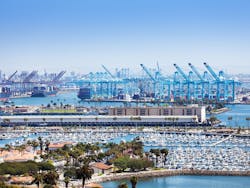Port of Long Beach, Schneider Electric start construction on $12.2 million microgrid project
The Port of Long Beach and Schneider Electric have started construction on a $12.2 million microgrid project that will provide reliable, zero-emissions electricity for the port’s Joint Command and Control Center. Funded in part by a grant from the California Energy Commission, the microgrid is expected to be online in November.
In 2018, Schneider Electric was awarded the contract to design, engineer and construct the Port of Long Beach’s microgrid, which includes a 300-kW PV solar panel array and a 250-kW stationary battery energy storage system. When completed, it’s expected to produce 520 MWh annually, reducing the port’s reliance on diesel backup generators. The microgrid is also projected to reduce the port’s electric costs by more than $60,000 a year.
“Recent supply chain challenges underscore the Port of Long Beach’s importance and the need to maintain their operation to keep goods — and the economy — moving,” said Mark Feasel, president of smart grid North America at Schneider Electric. “Adding a microgrid will enhance their critical energy resilience for greater reliability and business continuity, while increasing operational safety and environmental sustainability. This distributed power source offers energy security to maintain their operation and more predictable energy costs to support their bottom line.”
The goal of the project is to improve the port’s energy resilience and move toward a zero-emissions future, according to Mario Cordero, the port’s executive director. In a statement, Cordero said, “Our move toward large-scale energy resilience in the future will benefit the surrounding communities by taking power demand off the utility grid, especially during extreme heat events when rolling blackouts occur.”
Steven Neal, president of the Long Beach Board of Harbor Commissioners said, “Generating power with a new microgrid will enhance reliability for the port’s critical security operations during an outage on the utility grid.”
Prior to the start of construction, the City of Long Beach and its Board of Harbor Commissioners challenged a January 2021 tariff decision made by the California Public Utilities Commission (CPUC). Long Beach argued that the CPUC had not removed major barriers to microgrid development, as was required by state law SB1339. The CPUC eventually rejected the city’s claims.
Long Beach isn’t the only port in Southern California investing in microgrids. The Port of San Diego has plans to construct its own microgrid, which Marshall Merrifield, a Port of San Diego Board of Port commissioner called “the crown jewel in our efforts to achieve the goals in our climate action plan.”
Track news about the Port of Long Beach microgrid project. Subscribe to the free Microgrid Knowledge newsletter.
About the Author
Kathy Hitchens
Special Projects Editor
I work as a writer and special projects editor for Microgrid Knowledge. I have over 30 years of writing experience, working with a variety of companies in the renewable energy, electric vehicle and utility sector, as well as those in the entertainment, education, and financial industries. I have a BFA in Media Arts from the University of Arizona and a MBA from the University of Denver.

